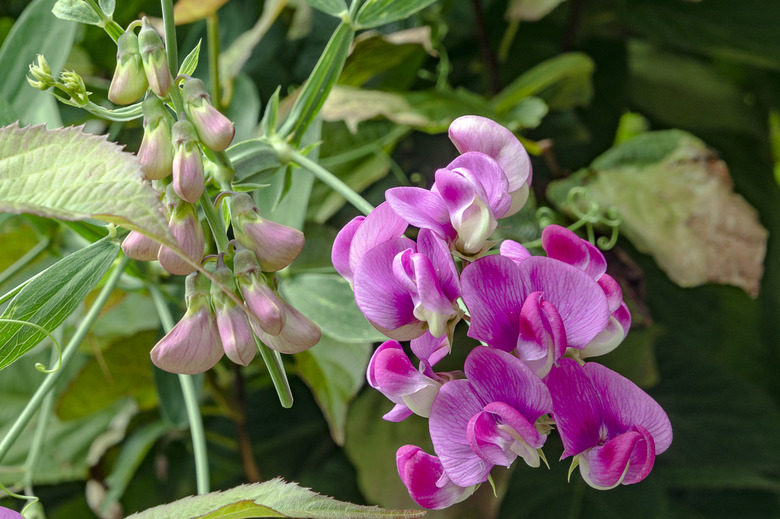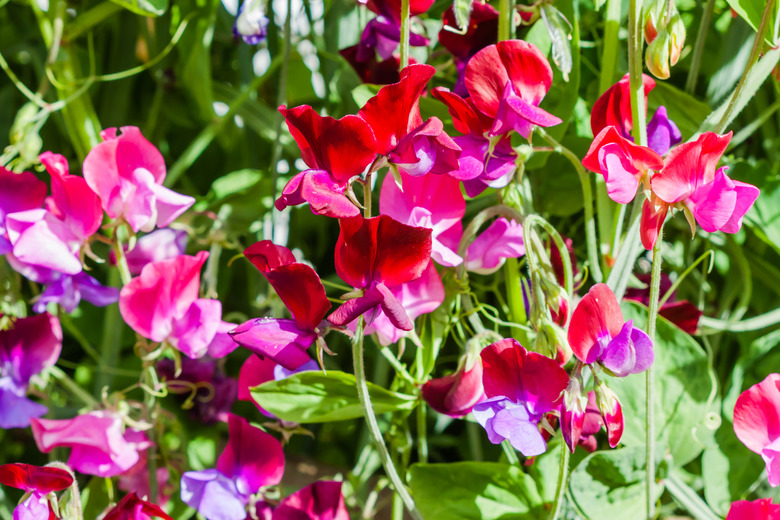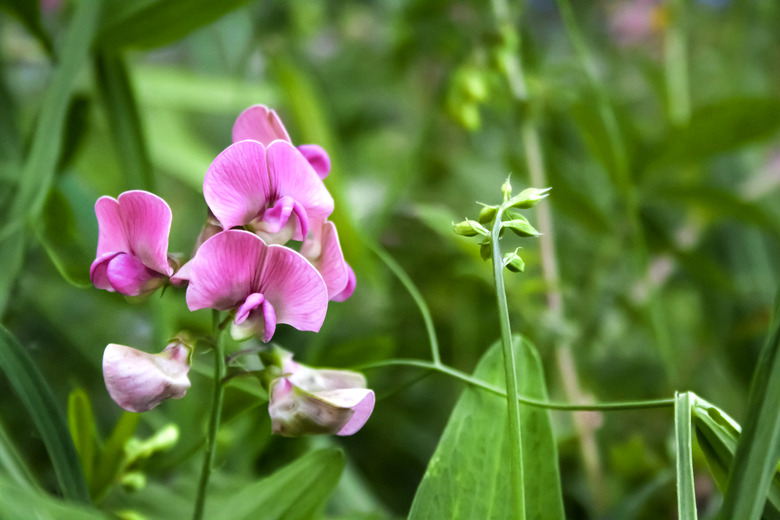How To Grow Sweet Peas
We may receive a commission on purchases made from links.
Gentle spring breezes may bring the nostalgic fragrance of sweet peas (Lathyrus odoratus) to garden visitors even before they see the flowers, and a handful of sweet peas in a vase will perfume an entire room with their intoxicating scent. These old-fashioned favorites have such enduring appeal that no cottage garden is fully complete without them. As cool-weather annuals, some sweet peas climb on trellises, and others fill window boxes.
In sharp contrast to the edible garden pea (Pisum sativum), which is in the same plant family, sweet pea is poisonous when eaten. There's even a medical term to describe the toxic effects of sweet pea — lathyrism. When large quantities are eaten, particularly the seeds, symptoms include slow and weak pulse, shallow breathing, convulsions and paralysis. Needless to say, unlike other edible flowers that garnish plates and add color and flavor to salads, sweet peas are not for the table.
Don't let its toxic quality dissuade you from handling sweet peas, though, because the plants do not cause contact dermatitis. You can sow seeds, prune plants, and cut flowers without experiencing adverse effects, and breathing in their sweet scent is only metaphorically intoxicating to the senses — not physically harmful.
Best Uses for Sweet Peas
Best Uses for Sweet Peas
The method of growing sweet peas depends on the type you have selected. Climbing sweet peas are clasping vines with tendrils that coil around supports as the plants grow upward. These fast-growing annuals climb 6 to 8 feet in a single growing season. Bush-type sweet pea plants are dwarf types that grow into a 2-foot-tall bush.
Climbers will require a growing support such as an arbor, trellis, or even a chain-link fence. You can even grow climbing sweet peas in a container. Sow the seeds around the rim of a pot that also contains a trellis or bamboo stakes formed into a tent shape. As the vines grow, they'll clasp the support and climb upward.
To revel in their fragrance, plant a window box filled with bush-type sweet peas that you can enjoy while sitting indoors beside the open window. Fill patio pots or deck containers with these sweetly scented flowers near your favorite outdoor sitting area to enjoy a sensory treat as you sit outside and sip coffee on cool spring mornings.
In the landscape, sweet peas add color and fragrance to a border garden, an island bed or a cottage garden. You can help the plants have a longer bloom season simply by cutting the flowers. When you cut the blooms, you'll prevent seed pods from forming, prompting the plants to continue producing flowers. In the home, the blossoms are irresistible. Sweet pea flowers are formed in clusters, so even a few stems in a vase will provide numerous blossoms.
How to Grow Sweet Peas
How to Grow Sweet Peas
Starting Sweet Peas From Seed
Sow sweet pea seeds in place, ideally in early spring. If you live in a warm climate, you can sow them in late fall or winter (November through January) for spring blooms. You can also start seeds indoors six to eight weeks before the last spring frost date.
Sweet pea seeds have a hard seed coat. Nicking the seed coat and soaking the seeds overnight in water may help optimize germination. You can dig a trench and place seeds along its length or sow individual seeds. Sow the large seeds to a depth recommended on the seed packet, which generally is about 1 inch, and thin seedlings to a spacing of 6 inches apart for climbing types and 12 inches apart for bush types.
If you start sweet pea seeds indoors, sow the seeds in biodegradable pots filled with a soilless seed starter mix so that you can plant the entire pots containing the seedlings into the garden so as not to disturb the roots. Typically, pots are made of peat or coir, and you can find them as individual pots or attached sheet pots. Simply cut away each attached pot when it's time to transplant the seedlings in the garden.
Warning
When starting sweet peas from seed, remember that the seeds are toxic if ingested, so be sure to keep the seeds away from children and pets.
Starting Sweet Peas From Seedlings
Typically, sweet peas are best started from seeds because their roots sometimes don't take well transplanting, but you may be able to find some seedlings at your local nursery or garden center. If you purchase seedlings that are in plastic pots, be careful not to disturb the roots too much when removing the plants from the pots and setting them in your garden.
Some sweet pea seedlings are in peat or coir pots and they do not need to be removed from the pots before planting. Others come in plastic pots. In both these cases, clip off any flowers or flower buds before transplanting. This will help the growing seedlings direct more initial energy toward root development instead of flower production, thereby producing stronger plants.
Set out transplants in the garden (or in containers such as window boxes) no deeper than they were growing in their pots. You may need to tear off the top edges of peat or coir pots to keep water from wicking up these edges and away from the roots.
In What Zone Do Sweet Peas Grow Best?
In What Zone Do Sweet Peas Grow Best?
Although sweet peas grow as annuals in USDA zones 2 through 11, they reach their greatest potential when growing on cool soil in cool climates. In the deep South, sweet peas can be challenging to grow except in cool spring weather. In other climates, sweet peas may continue to bloom through early summer, and in climates with very cool summers, plants may still be blooming in fall if regularly deadheaded.
Established plants can tolerate some frost without being damaged but be prepared to cover plants during extended frost periods. In warm climates, you can push the envelope with a longer bloom season by planting sweet peas in a container in late winter and early spring that you can move indoors on extremely cold nights when a hard freeze is expected.
When to Plant Sweet Peas
When to Plant Sweet Peas
Each climate region has its own optimal time frame for planting sweet peas. In the deep South and other regions with hot summers, gardeners can sow seeds between Thanksgiving and Christmas. In regions with cooler summers, gardeners start sweet pea seeds indoors about six to eight weeks before the last spring frost, or they direct-sow seeds in the garden after the last frost. Regardless of when you sow seeds or transplant seedlings, it's best to place supports in the ground at planting time so you don't disturb the roots of established plants.
Soil, Sunlight, and Water Recommendations
Soil, Sunlight, and Water Recommendations
Sweet peas flourish when planted on soil that's rich in decomposed organic matter, such as compost, well-aged manures, humus or leaf mold. Poor soil can be amended by incorporating organic matter to enrich it and make it looser for sweet pea's delicate roots to become established.
Plants perform to their potential when planted in full sun. Although they'll tolerate partial shade, they may not produce as many flowers if they receive too much shade.
Sweet peas respond best to soil that's evenly moist but well-draining. Avoid overhead irrigation, such as from sprinklers, because wet foliage may promote fungal diseases. Direct water at the roots by using a water wand on your garden hose, drip irrigation or soaker hoses. A 2- to 3-inch layer of mulch around plants not only helps conserve soil moisture but also helps keep the soil cool to optimize sweet peas' performance.
A soil test reveals the exact nutritional deficiencies or excesses of the site where you'll be growing sweet peas. Fertilize plants according to the recommendations of a soil test. In the absence of soil test results, fertilize once monthly with a water-soluble fertilizer, following all label recommendations for the specific product you choose.
How to Propagate Sweet Peas
How to Propagate Sweet Peas
Sweet peas are best propagated by seed, but you'll sacrifice lots of flowers if you let your plants go to seed too quickly. Cut flowers for indoor bouquets or deadhead spent flowers to keep plants blooming. When your plants are nearing the end of their annual life — typically when the weather is getting hot — let the remaining flowers fade on the plants. They'll form seedpods, which you'll remove when they're mature, and you can save the seeds to sow for next season's flowers.
Hybrid cultivars may not come true to seed, so you may want to look for heirloom sweet peas if you're planning to save seeds. Wait until the seedpods are fully dry and ready to fall from the plants before removing them and extracting the seeds. By this time, the plants will look a bit shabby but resist the urge to remove the seedpods before they mature, or they will not germinate the following year. Keep the seeds in a cool, dry place; a paper envelope is better than a glass container, which may retain moisture that promotes mold growth on the seeds.
Common Pests and Problems
Common Pests and Problems
Sweet peas are not generally bothered by insects and other garden pests. If you see aphids, knock them off plants with a gentle stream of water, being careful not to remove climbing plants from their support. You may find a spray bottle that's filled with water and set on a stream or jet setting to be easier to use and gentler on plants.
When plants are young, slugs and snails may want to feast on the tender growth. You can use commercial slug bait or prepare your own by dissolving 3 teaspoons of yeast in 1 cup of warm water. Place the homemade bait in shallow containers and sink the containers into the ground around the plants, leaving a 1- to 2-inch lip above the soil line.
Common Diseases for Sweet Peas
Common Diseases for Sweet Peas
In humid climates or areas of excessive spring rainfalls, sweet peas may be vulnerable to powdery mildew. Overhead irrigation is also a culprit because it directs water on the leaves instead of at the ground near the root zone. The best way to combat mildew problems is to prevent it by spacing plants so that air can freely circulate around them and by avoiding overhead irrigation.
To mitigate other disease problems, it's important not to plant sweet peas in the same location each year or to plant them in locations where other members of the pea family, such as the garden pea, have grown. Optimally, find a new garden location for your sweet peas every few years to avoid infecting them with soilborne pathogens from the previous year's plants.


